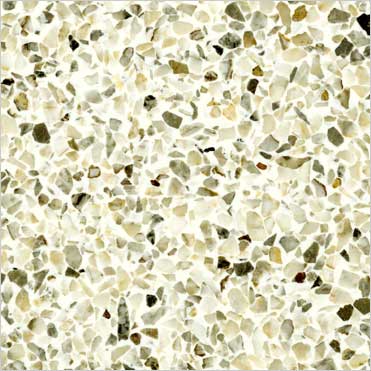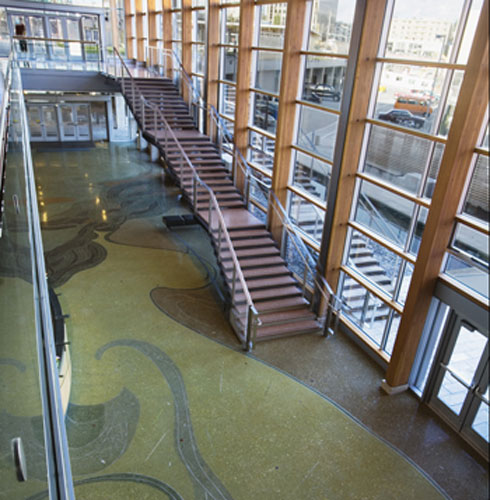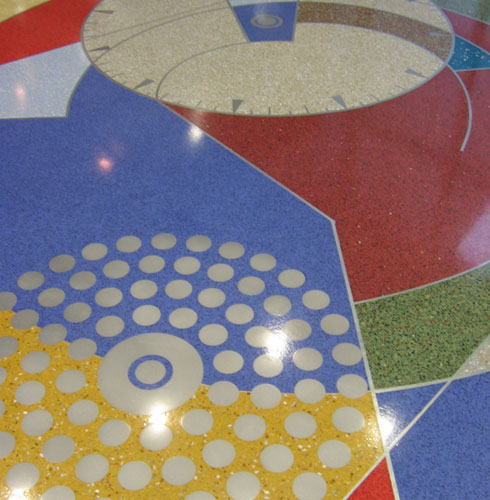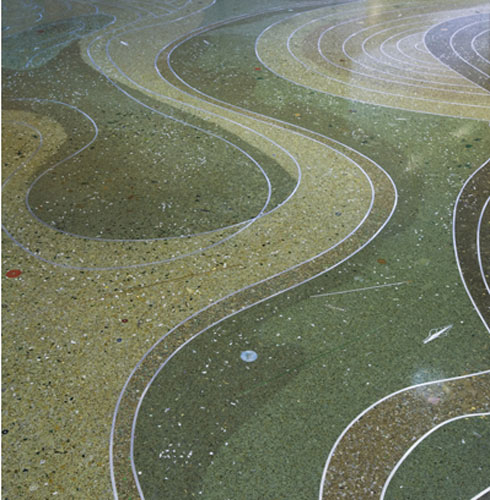Prior to the mid-'50s, houses built here were timber frame homes that sat on pylons about two feet off the ground. These frame homes had framed floors. For the most part; homes here don't have foundations. This is due to the proximity of the water table to the surface of the earth, and it's also due to the staggering volumes of rain water that fall during the rainy season. So without a foundation, traditional home builders here simply made sure that a home didn't sit on the ground. Around the middle of the last century though, somebody figured out how to pour a slab foundation from concrete and to build a home directly on that slab. Enter the Florida rancher.
 Almost all of these sitting-on-a-slab ranch homes had terrazzo floors. Terrazzo is a flooring material that the Romans perfected and the terrazzo floors all over Florida are essentially the same thing the Romans used. A slurry of concrete and decorative stone aggregates is spread over a prepared surface and then the mixture is leveled. Once cured, the top layer of the concrete and aggregate mix is ground off; leaving a smooth, shiny floor with a distinctive pattern of random stone pieces in it. A typical, vintage terrazzo floor looks like the image to the left.
Almost all of these sitting-on-a-slab ranch homes had terrazzo floors. Terrazzo is a flooring material that the Romans perfected and the terrazzo floors all over Florida are essentially the same thing the Romans used. A slurry of concrete and decorative stone aggregates is spread over a prepared surface and then the mixture is leveled. Once cured, the top layer of the concrete and aggregate mix is ground off; leaving a smooth, shiny floor with a distinctive pattern of random stone pieces in it. A typical, vintage terrazzo floor looks like the image to the left.The native Floridians I know shudder at the thought of a Terrazzo floor. I think they're beautiful though. I suppose that people grow to resent what they grew up with and my native Floridian friends' bad reaction to Terrazzo is the same as my urge to vomit when I see hex signs or other Pennsylvania Dutch accouterments.
Traditional terrazzo is a labor-intensive and as building trade labor has become more valuable, the price of a new terrazzo floor became prohibitive and at some point in the mid-'70s, terrazzo was largely abandoned.
 But terrazzo is making a comeback. It's starting to show up all over the place in public spaces and in private homes. The new terrazzo is a bit different than the vintage stuff and in a lot of ways it's a better deal. It's certainly less expensive. New terrazzo uses epoxy resins instead of concrete as a base. That's the first difference. In using an epoxy, the resulting floor is non-porous and highly stain resistant. Since the base material is manufactured and is essentially moldable plastic, it can be made in virtually any color. In a nod to the idea of sustainability, the aggregates used in the new stuff tend to be things like recycled glass and cast off stone from quarries. The new terrazzos have the same shiny stone feel of the old ones and they are virtually maintenance-free.
But terrazzo is making a comeback. It's starting to show up all over the place in public spaces and in private homes. The new terrazzo is a bit different than the vintage stuff and in a lot of ways it's a better deal. It's certainly less expensive. New terrazzo uses epoxy resins instead of concrete as a base. That's the first difference. In using an epoxy, the resulting floor is non-porous and highly stain resistant. Since the base material is manufactured and is essentially moldable plastic, it can be made in virtually any color. In a nod to the idea of sustainability, the aggregates used in the new stuff tend to be things like recycled glass and cast off stone from quarries. The new terrazzos have the same shiny stone feel of the old ones and they are virtually maintenance-free.
 Since they are no longer being used as a cheap floor in mass-produced housing, the new terrazzos are as often as not designed and installed by true craftspeople and artists. Here are a few examples of this new terrazzo. In the hands of a competent professional, the sky's the limit. Or should that be the floor's the limit?
Since they are no longer being used as a cheap floor in mass-produced housing, the new terrazzos are as often as not designed and installed by true craftspeople and artists. Here are a few examples of this new terrazzo. In the hands of a competent professional, the sky's the limit. Or should that be the floor's the limit?You can learn all about the new terrazzo floors and see some great examples of them in actual homes and businesses at the website of the National Terrazzo and Mosaic Association (www.ntma.com).
No comments:
Post a Comment
Talk to me!